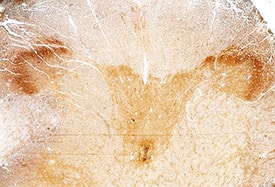Human RGM-A Antibody
R&D Systems, part of Bio-Techne | Catalog # AF2459


Key Product Details
Species Reactivity
Validated:
Cited:
Applications
Validated:
Cited:
Label
Antibody Source
Product Specifications
Immunogen
Cys48-Gly422
Accession # Q96B86
Specificity
Clonality
Host
Isotype
Scientific Data Images for Human RGM-A Antibody
RGM‑A in Human Brain.
RGM-A was detected in immersion fixed paraffin-embedded sections of human brain (spinal cord) using Goat Anti-Human RGM-A Antigen Affinity-purified Polyclonal Antibody (Catalog # AF2459) at 15 µg/mL overnight at 4 °C. Before incubation with the primary antibody, tissue was subjected to heat-induced epitope retrieval using Antigen Retrieval Reagent-Basic (Catalog # CTS013). Tissue was stained using the Anti-Goat HRP-DAB Cell & Tissue Staining Kit (brown; Catalog # CTS008) and counterstained with hematoxylin (blue). Specific staining was localized to the dorsal horn. View our protocol for Chromogenic IHC Staining of Paraffin-embedded Tissue Sections.Applications for Human RGM-A Antibody
Immunohistochemistry
Sample: Formalin fixed paraffin-embedded sections of human spinal cord subjected to Antigen Retrieval Reagent-Basic (Catalog # CTS013)
Western Blot
Sample: Recombinant Human Repulsive Guidance Molecule A/RGM-A (Catalog # 2459-RM)
Formulation, Preparation, and Storage
Purification
Reconstitution
Formulation
Shipping
Stability & Storage
- 12 months from date of receipt, -20 to -70 °C as supplied.
- 1 month, 2 to 8 °C under sterile conditions after reconstitution.
- 6 months, -20 to -70 °C under sterile conditions after reconstitution.
Background: RGM-A
Human Repulsive Guidance molecule (RGM) is a 33 kDa GPI-linked member of an expanding RGM-related family of neuronal and muscle-expressed membrane proteins (1). It is synthesized as a 450 amino acid (aa) preproprotein that contains a 47 aa signal sequence, a 121 aa N-terminal prosegment, a 256 mature region and a 26 aa C-terminal prosegment (2). The N-terminal prosegment contains an RGD tripeptide and the molecule’s only two potential N-linked glycosylation sites. The mature segment shows an abbreviated von Willebrand factor domain. Proteolytic processing occurs at an aspartic acid-proline bond, creating a predicted 32 kDa mature region (2). The mature region of human RGM-A has 88% and 93% aa identity to the chick and mouse mature region of RGM-A, respectively. When compared to human RGMb and c, the mature region of human RGM-A shows 58% and 54% aa identity, respectively. Recombinant chick RGM-A has been reported to induce collapse of temporal but not nasal growth cones, and to repel temporal retinal axons in vitro. This suggests a role in the development of the retina-superior colliculus connection. In mammals, however, this activity is not so evident, and thus its function in this system is uncertain (3). Alternatively, in mice, RGM-A is said to be needed for neural tube closure, and may play a role in entorhinal-hippocampal connections (3, 4). The receptor for RGM-A is reported to be neogenin (5, 6). RGM-A has also been shown to be a bone morphogenic protein co-receptor, able to bind both BMP-2 and BMP-4 (7).
References
- Samad, T.A. et al. (2004) J. Neurosci. 24:2027.
- Monnier P. et al. (2002) Nature 419:392.
- Niederkofler V. et al. (2004) J. Neurosci. 24:808.
- Brinks, H. et al. (2004) J. Neurosci. 24:3862.
- Rajagopalan S. et al. (2004) Nat. Cell Biol. 6:756.
- Matsunaga E. et al. (2004) Nat. Cell Biol. 6:749.
- Babitt J.L. et al. (2005) J. Biol. Chem. 280(33):29820.
Long Name
Alternate Names
Gene Symbol
UniProt
Additional RGM-A Products
Product Documents for Human RGM-A Antibody
Product Specific Notices for Human RGM-A Antibody
For research use only